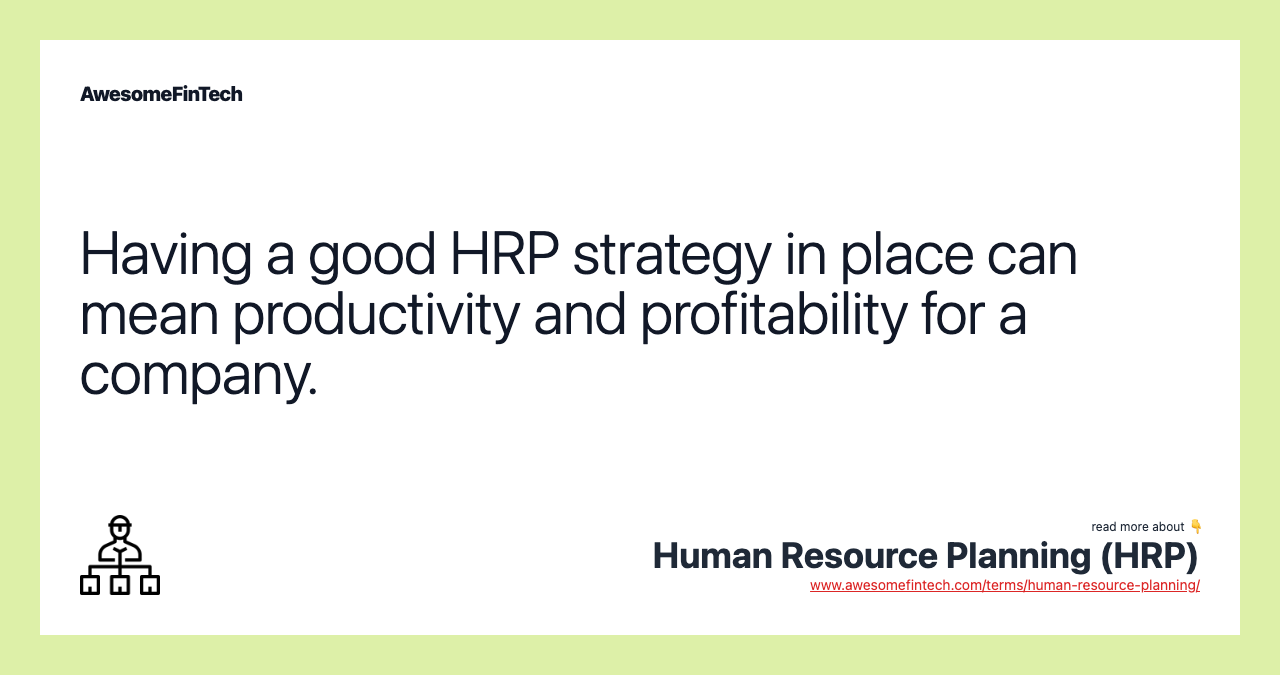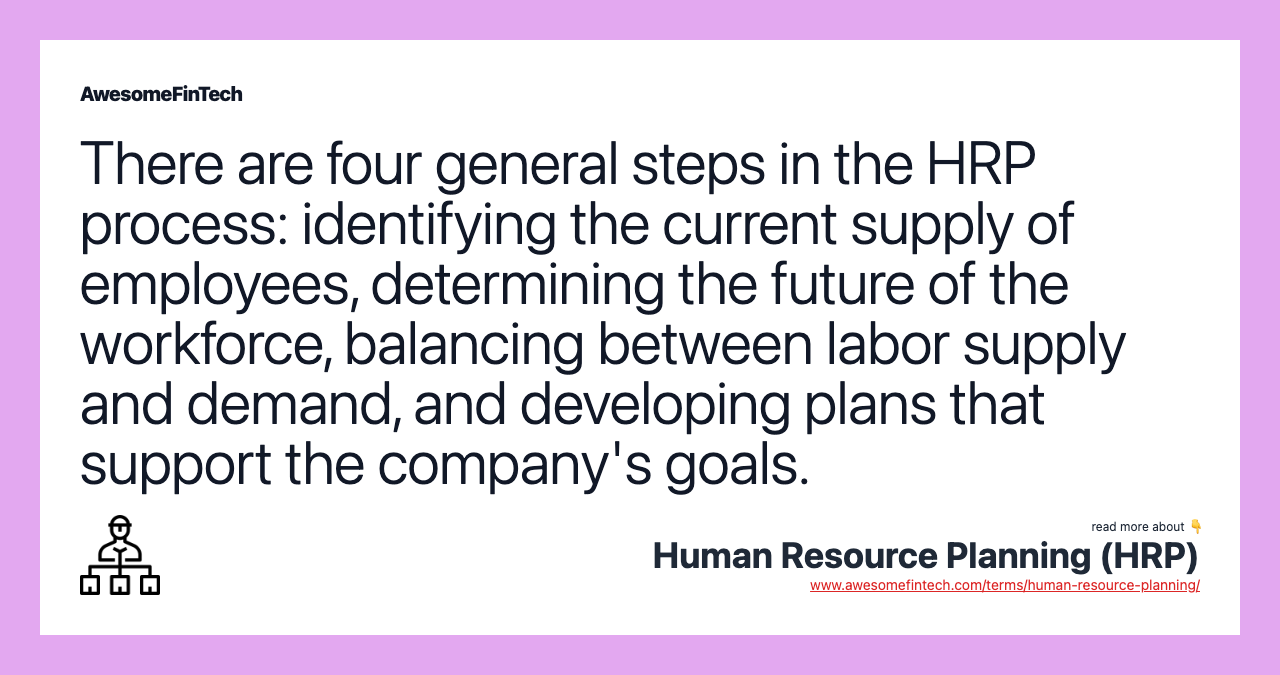Human Resource Planning (HRP)
Human resource planning (HRP) is the continuous process of systematic planning ahead to achieve optimum use of an organization's most valuable asset — quality employees. There are four general steps in the HRP process: identifying the current supply of employees, determining the future of the workforce, balancing between labor supply and demand, and developing plans that support the company's goals. Human resource planning (HRP) is a strategy used by a company to maintain a steady stream of skilled employees while avoiding employee shortages or surpluses. Each step needs to be taken in sequence in order to arrive at the end goal, which is to develop a strategy that enables the company to successfully find and retain enough qualified employees to meet the company's needs. Human resource planning (HRP) allows a business to better maintain and target the right kind of talent to employ - having the right technical and soft skills to optimize their function within the company.

What Is Human Resource Planning (HRP)?
Human resource planning (HRP) is the continuous process of systematic planning ahead to achieve optimum use of an organization's most valuable asset — quality employees. Human resources planning ensures the best fit between employees and jobs while avoiding manpower shortages or surpluses.
There are four key steps to the HRP process. They include analyzing present labor supply, forecasting labor demand, balancing projected labor demand with supply, and supporting organizational goals. HRP is an important investment for any business as it allows companies to remain both productive and profitable.



Understanding Human Resource Planning
Human resource planning allows companies to plan ahead so they can maintain a steady supply of skilled employees. That's why it is also referred to as workforce planning. The process is used to help companies evaluate their needs and to plan ahead to meet those needs.
Human resource planning needs to be flexible enough to meet short-term staffing challenges while adapting to changing conditions in the business environment over the longer term. HRP starts by assessing and auditing the current capacity of human resources.
Challenges of Human Resource Planning
The challenges to HRP include forces that are always changing, such as employees getting sick, getting promoted, or going on vacation. HRP ensures there is the best fit between workers and jobs, avoiding shortages and surpluses in the employee pool.
To satisfy their objectives, HR managers have to make plans to do the following:
Investing in HRP is one of the most important decisions a company can make. After all, a company is only as good as its employees, and a high level of employee engagement can be essential for a company's success. If a company has the best employees and the best practices in place, it can mean the difference between sluggishness and productivity, helping to lead a company to profitability.
Steps to Human Resource Planning
There are four general, broad steps involved in the human resource planning process. Each step needs to be taken in sequence in order to arrive at the end goal, which is to develop a strategy that enables the company to successfully find and retain enough qualified employees to meet the company's needs.
Analyzing Labor Supply
The first step of human resource planning is to identify the company's current human resources supply. In this step, the HR department studies the strength of the organization based on the number of employees, their skills, qualifications, positions, benefits, and performance levels.
Forecasting Labor Demand
The second step requires the company to outline the future of its workforce. Here, the HR department can consider certain issues like promotions, retirements, layoffs, and transfers — anything that factors into the future needs of a company. The HR department can also look at external conditions impacting labor demand, such as new technology that might increase or decrease the need for workers.
Balancing Labor Demand With Supply
The third step in the HRP process is forecasting the employment demand. HR creates a gap analysis that lays out specific needs to narrow the supply of the company's labor versus future demand. This analysis will often generate a series of questions, such as:
Developing and Implementing a Plan
The answers to questions from the gap analysis help HR determine how to proceed, which is the final phase of the HRP process. HR must now take practical steps to integrate its plan with the rest of the company. The department needs a budget, the ability to implement the plan, and a collaborative effort with all departments to execute that plan.
Common HR policies put in place after this fourth step may include policies regarding vacation, holidays, sick days, overtime compensation, and termination.
Special Considerations
The goal of HR planning is to have the optimal number of staff to make the most money for the company. Because the goals and strategies of a company change over time, human resource planning is a regular occurrence. Additionally, as globalization increases, HR departments will face the need to implement new practices to accommodate government labor regulations that vary from country to country.
The increased use of remote workers by many corporations will also impact human resource planning and will require HR departments to use new methods and tools to recruit, train, and retain workers.
Frequently Asked Questions
Why Is Human Resource Planning Important?
Human resource planning (HRP) allows a business to better maintain and target the right kind of talent to employ - having the right technical and soft skills to optimize their function within the company. It also allows managers to better train and develop the skills needed amongst the workforce.
What Is "Hard" vs. "Soft" Human Resource Planning?
Hard HRP evaluates various quantitative metrics to ensure that the right number of the right sort of people are available when needed by the company. Soft HRP focuses more on finding employees with the right corporate culture, motivation, and attitude. Often these are used in tandem.
What Are the Basic Steps in HRP?
HRP begins with an analysis of the available labor pool from which they can draw from. It then evaluates the firm's present and future demand for various types of labor and attempts to match that demand with the supply of job applicants.
Related terms:
Best Practices
Best practices are a set of guidelines, ethics, or ideas that represent the most efficient or prudent course of action for a business or investor. read more
Budget : Corporate & Personal Budgets
A budget is an estimation of revenue and expenses over a specified future period of time and is usually compiled and re-evaluated on a periodic basis. read more
Contingency
A contingency is a potential negative event that may occur in the future, such as a natural disaster, fraudulent activity or a terrorist attack. read more
Demand For Labor
The demand for labor describes the amount and market wage rate workers and employers settle upon at any given moment. read more
Economics : Overview, Types, & Indicators
Economics is a branch of social science focused on the production, distribution, and consumption of goods and services. read more
Employee Engagement and Example
Employee engagement is a human resources concept that describes the level of enthusiasm and dedication a worker feels toward their job. read more
Entrepreneur & Entrepreneurship + Types
Entrepreneurs and entrepreneurship have key effects on the economy. Learn how to become one and the questions you should ask before starting your entrepreneurial journey. read more
Enterprise Resource Planning (ERP)
Enterprise resource planning (ERP) is used by a company to manage key parts of its business such as accounting, manufacturing, sales, and marketing. read more
Forecasting
Forecasting is a technique that uses historical data as inputs to make informed estimates that are predictive in determining the direction of future trends. read more
Gap Analysis
Gap analysis is the process companies use to examine their current performance with their desired, expected performance. read more